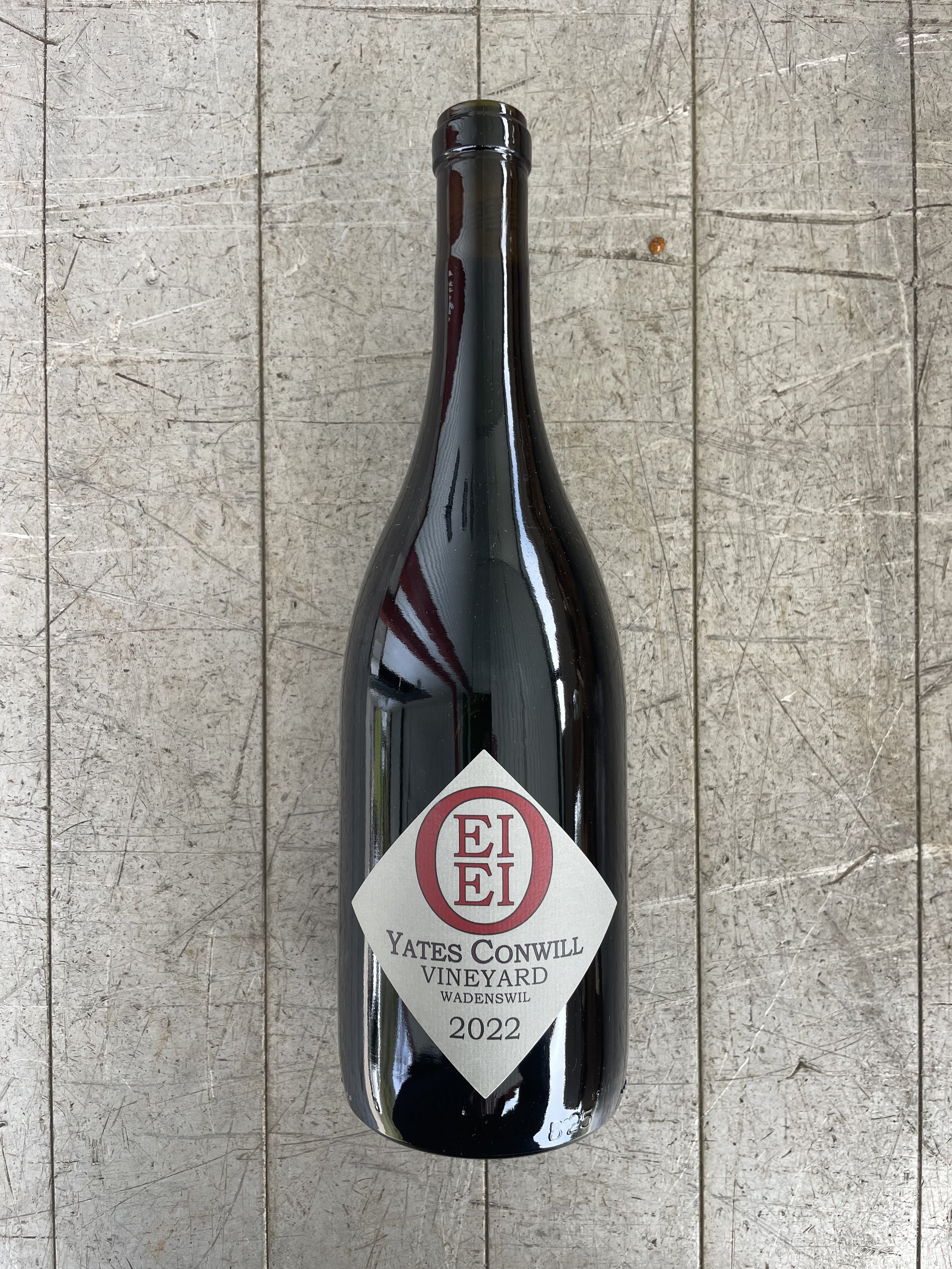SPECIAL ACCESS
2022 YATES CONWILL VINEYARD TRIO
WILLAMETTE VALLEY AVA
$75 PER BOTTLE
offer available in the following shipping packs
Three Pack: $225 | Six Pack: $450 | Case: $900
Shipping not included
Members savings apply so long as they are in good standing.
Complimentary pick up at the winery is available, weather permitting, for orders of six bottles or more.
Offer expires May 5th or when sold out, whatever comes first.
Hope you are reading this... Any additional state or federal governmental taxes, fees, dues, bribes, backsheesh, vigs, filings or hassle factors will be invoiced additionally.
TASTING NOTES
2022 YATES CONWILL PINOT NOIRS
A Burgundy Lovers Line Up.
ART LABEL
Darkest in color. Aromas of BIC blue pen ink when it leaked into your shirt pocket. Lush entry with lovely talc-like tannins present on the entry. Flavors now of fresh meat and black plums. Round mouthfeel. More evolved. With 30 minutes, vitamin B aromas, meaty and medicine. Rounder entry, enveloping yet more astringent. Drink today through 2034.
WADENSWIL
Lightest in color. Aromas of dusty raspberries on toast, no butter. Smooth entry, almost non-existent weight on the palate, in a good way, like a crisp glass of water. Red fruits and finesse. Stylistically like Domaine Bruno Clair, but for one tenth the price. Most Burgundian in style: aromatics and acid over fruit and body. With 30 minutes of air, more spice on the nose of cinnamon and cardamom. Another hour and the classic aroma of hot cast iron skillet is present. Smoother texture on entry. Cellar for another two years.
POMMARD
Smells of sweet red cherries warmed in a bowl by the sun. Very faint nose. Entry is round and coats the mouth offering up flavors ranging from yellow Mirabelle plums to red plum meat near the pit. Great acidity, more akin to Burgundy in the acidity than New World Pinots. Will probably age for a long while. Clean and refreshing. Most “Ore-gundian” in style as it has the ethereal aromatics and the mid-palate stuffing followed by a complex and intriguing finish, yet on a lighter, chamber music scale. Flavors of red plums, raspberries, Rainier cherries. With 30 minutes: more sour cherry preserves on dry toast. Post aeration with device: Much smoother entry but more tannin on initial finish. No real change in aromas or flavors, just more astringent. Drink today through 2039.
You might notice the number 333 encircled and speared in the rear label. This is my "luck of the draw" BATF Oregon Bonded Winery Number, and is becoming a stand-alone label as I separate EIEIO from the purist pursuit of 333.
WINEMAKER’S NOTES
This is the first vintage where I have crafted three separate Yates Conwill Vineyard bottlings:
ART LABEL: a blend of blocks from across the vineyard
For the art label in this vintage, we have crafted a blend of pinot from three blocks, each with a distinct clone and microclimate expression. The label is an artistic rendition of the vineyard blocks selected.
CLONAL SELECTION: WADENSWIL
Our second pinot bottling is from a single block of own-rooted Wadenswil clone. Wadenswil, said to have originally been propagated in the town of the same name in Switzerland.
CLONAL SELECTION: POMMARD
Finally, we offer a bottling from a single block of own-rooted Pommard clone. Believed to have been culled from vineyards in Burgundy in the 1940's and brought to California, the Pommard clone is known to produce wine that are powerful and structured, but retail the elegance expected of pinot.
The two traditional appearing labels are the blocks of Wadenswil and Pommard cuttings gleaned from the adjacent Resonance Vineyard, which was planted in 1981 where the cuttings were placed in the ground next door at Yates Conwill in 2005. The plants grew roots out of the cuttings on their own, without any grafting onto other "rootstock".
A note on the own-rooted vines:
Grape plants are vines and they are tenacious. Most vinifera is now grafted onto a “rootstock” chosen for its ability to resist phylloxera as well as water intake characteristics. This is a safe way to plant a vineyard. The plants within these Own-Roots blocks are cuttings taken from the neighboring vineyard currently known as Resonance Vineyard. You cut off a piece of the fruiting cane in the winter and stick it in the ground in the early spring. These cuttings took hold and are producing quality fruit, year after year.
Anecdotally, I find that vines growing with their own roots not only ripen later, but also do not seem to take in more water when there is a late in season rain event. I have yet to see these berries split during large downpours such as we had in 2013. Perhaps that is why my wines from Yates Conwill did so well with the critics that year.
If you really want to geek out on the various "clones" of Pinot noir, this is a great write-up.
Yates Conwill Vineyard | Yamhill-Carlton AVA
THE VINEYARD
Having leased Yates Conwill Vineyard for seventeen years now, I have consistently achieved great results, year in and year out, therefore, it must be the site and the farming. The vineyard has been described as a bonsai garden it is so well tended. I agree.
“I am starting to believe the underlying sea basalt based rock formations give this site an over-all salted plum-like flavor followed by fresh meaty savory notes. The closest I can come to this would be Umeboshi which you can buy at Asian markets. Seriously, taste one of these then drink the Yates Conwill Pinot and you will understand. Reading of how Umeboshi is a cure for hangovers is also interesting as I have yet to be hungover on any of my wines made from the Yates Conwill Vineyard...”




